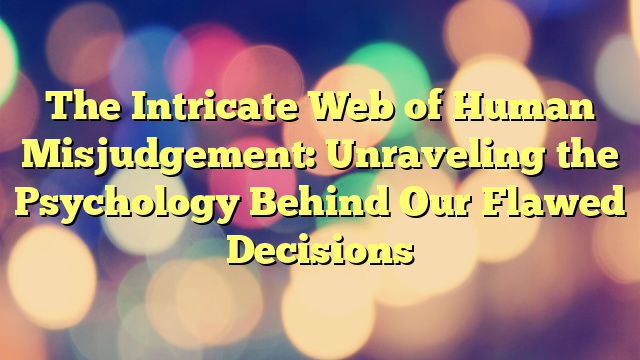The Intricate Web of Human Misjudgement: Unraveling the Psychology Behind Our Flawed Decisions
The Intricate Web of Human Misjudgement: Unraveling the Psychology Behind Our Flawed Decisions
Introduction
Human beings are often considered rational creatures capable of making logical decisions. However, numerous studies have shown that our decision-making processes are far from perfect. In fact, our decisions are often influenced by a complex web of biases, heuristics, and cognitive shortcuts that can lead to flawed outcomes. Understanding the psychology behind these flawed decisions is crucial for improving our decision-making abilities and avoiding costly mistakes.
The Influence of Cognitive Biases
One of the key factors that contribute to flawed decision-making is the presence of cognitive biases. These biases are mental shortcuts that our brains take to simplify the decision-making process. While they can be helpful in certain situations, they often lead to errors in judgment.
One common cognitive bias is the confirmation bias, which refers to our tendency to seek out information that confirms our pre-existing beliefs and ignore evidence that contradicts them. This bias can prevent us from considering alternative viewpoints and lead to narrow-minded decision-making.
Another prevalent bias is the availability heuristic, where we rely on immediate examples that come to mind when making judgments. For example, if we hear about a few cases of plane crashes, we may overestimate the likelihood of such accidents occurring. This bias can lead to irrational fears and skewed risk assessments.
Furthermore, the anchoring bias influences our decisions by relying heavily on the first piece of information we receive. This initial anchor can heavily influence subsequent judgments, even if it is irrelevant or arbitrary. Advertisers often use this bias to their advantage by setting high initial prices and then offering discounts, making the discounted price seem more appealing.
The Power of Heuristics
In addition to biases, our decision-making is also influenced by heuristics. Heuristics are mental shortcuts that allow us to make quick judgments and decisions based on limited information. While heuristics can be efficient, they can also lead to errors and flawed decisions.
One common heuristic is the representativeness heuristic, where we make judgments based on how closely something resembles a typical example. For example, if someone fits our stereotype of a successful entrepreneur, we may assume they are more likely to be successful, even if there is no concrete evidence to support this assumption. This heuristic can lead to stereotyping and overlooking important individual differences.
Another powerful heuristic is the availability heuristic, where we base our judgments on how easily examples come to mind. If we can easily recall instances of a particular event, we may overestimate its likelihood. For example, if we hear about multiple cases of shark attacks, we may believe that swimming in the ocean is extremely dangerous, even though the actual risk is relatively low.
Overcoming Flawed Decisions
Recognizing and understanding these biases and heuristics is the first step towards improving our decision-making abilities. By being aware of our tendency to rely on mental shortcuts and fall into cognitive traps, we can take steps to mitigate their influence.
One effective strategy is to actively seek out diverse perspectives and information that challenges our preconceived notions. By exposing ourselves to different viewpoints, we can broaden our understanding and make more informed decisions. Additionally, taking the time to gather and analyze relevant data can help counteract the influence of biases and heuristics.
Another approach is to engage in deliberate and systematic thinking. Instead of relying solely on intuition and gut feelings, we can consciously evaluate the pros and cons of different options and consider the potential biases that may be influencing our judgments. This analytical approach can help us make more rational decisions and avoid common pitfalls.
The Role of Education and Awareness
Education plays a crucial role in improving decision-making abilities. By teaching individuals about cognitive biases and heuristics, we can empower them to recognize and overcome these influences. Incorporating critical thinking and decision-making skills into school curricula can help equip future generations with the tools they need to make better choices.
Furthermore, raising awareness about the psychology behind flawed decisions can benefit society as a whole. By understanding the factors that contribute to flawed decision-making, we can design systems and processes that minimize their impact. This can lead to more effective policies, better organizational decision-making, and improved outcomes in various domains.
Conclusion
Human decision-making is a complex process influenced by a variety of factors. From cognitive biases to heuristics, our judgments are often flawed and prone to errors. However, by understanding the psychology behind these flawed decisions, we can take steps to improve our decision-making abilities. By recognizing biases, seeking diverse perspectives, and engaging in deliberate thinking, we can make more rational choices and avoid costly mistakes. Education and awareness also play a crucial role in equipping individuals with the skills needed to navigate the intricate web of human misjudgment.

